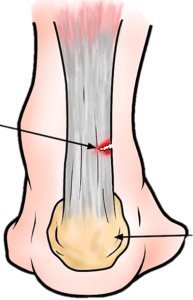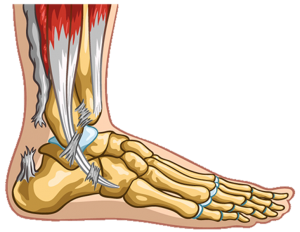Partial
A partial Achilles tendon rupture can occur in athletes from all sports but particularly in running, jumping, throwing and racket sports.The tendon will not completely tear and it may not be noticed until the activity is stopped.
Rupture
A total rupture of the Achilles tendon is a complete tear of the tendon and typically affects men over the age of 40. It is not always obvious if you have a completely torn Achilles tendon, but if you have, it is essential you seek medical attention as soon as possible
Symptoms
A Tear
Symptoms include :
Sudden sharp pain in the Achilles.
You may not feel pain at the time of the tear but later on or the next day when the tendon has cooled down and stiffened up.
.When returning to exercise after a short period of rest, there may be a sharp pain which disappears when warmed up only to return when stopped.
Stiffness in Achilles tendon first thing in the morning.
Swelling in the tendon

A Rupture
Symptoms include :
Sudden sharp pain in the Achilles.
The pain is often described as being struck on the back of your ankle
You may hear a loud snapping noise or bang at the time of injury.
You may see or feel a gap of 4 to 5 cm in your tendon immediately after injury.
You will have considerable loss of function and strength in the ankle.

Causes
A torn Achilles is simply a tear of the Achilles tendon. It can be a partial rupture or a total rupture. A total rupture is 10 times more common in men than in women.The Achilles tendon connects the calf muscles at the back of the lower leg and inserts at the back of the heel or calcaneus bone. Huge forces are transmitted through the tendon when running and jumping. The tendon itself is surrounded by a thin sheath. If the tendon tears but not completely. Scar tissue will form which is likely to lead to inflammation of the tendon.
- Typically it occurs 30 to 40 minutes into a period of exercise, rather than at the start of a session.
- Nearly always it results from either a sudden explosive movement or when forcibly bending the foot upwards (known as dorsiflexing).
- A rupture may (but not always) follow long term tendon pain which a patient may have put up with, or ignored for some time.
Treatment
Tear
Controlling pain and swelling:
- Apply cold therapy
- NSAID (Non-Steroidal Anti Inflammatory Drugs
- Rest the injury from aggravating activities
- Taping the Achilles tendon.
Controlling pain and swelling:
This may be within a few days but could be over a week depending on how bad the injury is. Calf Stretches and Ankle RoM
Strengthening exercises:
It is important that the tendon is strengthened in the stretched position by allowing the heels to drop below the toes. Calf Raises
Returning to full fitness:
When the ankle has regained full flexibility, there is no pain or swelling and strengthening exercises can be tolerated without adverse reaction then a gentle running programme can begin. This may be up to three months after the initial injury depending on severity.
Rupture
The conservative route involves initial immobilization to allow the tendon to heal, followed by strengthening and improving flexibility.
In most cases, Achilles tendon surgery is required and the sooner this takes place the higher the chances of success.
Contact Me
Let's chat!
Need more information? Send me an email or drop me a line. I don’t bite!
- Charlotte@rehabontheroad.co.uk
- 07971448719

